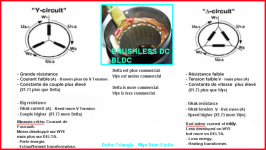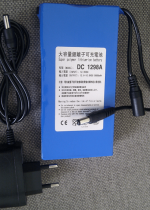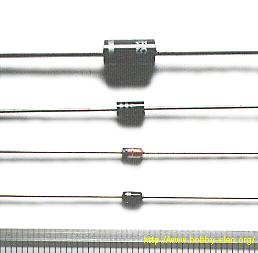Hello!
Directly of my holidays, I obtained a little of connection Wifi (very short!),
thus I takes advantage to give a little of information, that a guy of 20 years of work experience
in the manufacture of engine BLDC,
and thus he confirmed it:
Configuration of the winding:
The winding of the engine brushless
The engine is constituted by 3 reels, out of step of 120 °, coupled in star or in triangle. The couplings allow to privilege or the speed is the couple with a factor v3.
The constants of speed and couple have to correspond to the expected results:
For a strong impedance, the coupling in star with the mass reels is recommended.(X1.73 more Torque that Delta)
For a weak impedance, the coupling in triangle with reels in parallel is preferable.(X1.73 more Speed that Wye)
We obtain the same power with:
For coupling Wye: more tension for less of current.
For coupling Delta: less tension for more of current.
NAMELY ALSO:
Bad sides: current of Foucault.
Less developed on WYE but more on DELTA.
- Loss energy.
- Heating transformer.
Thus, for a work alternator in engine, Wye/star will ask for more tension V, but fewer amperes, and he will clear less heat at high speed.
And Delta, will ask for less tension V, but more amperes, and it will clear more heat at high speed.Then star is preferable to avoid losing the energy, and having less heat in transformers (reels), but star has to have more V to work, it gives more torque, and its speed can be adjusted to rotor with less V.
In my case, I consider not worked with more of 12V battery for this moment, then I would stay with triangle.
But I would make a test with wye/star on battery 12V, to notice the affimations of some.
PS:
" Certain people here already know this information, but she is useful for the not connoisseurs. "





